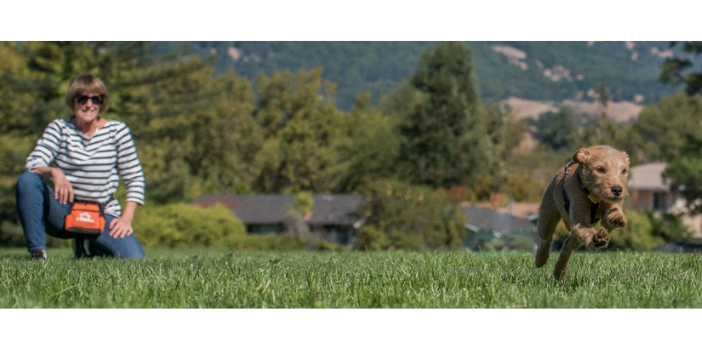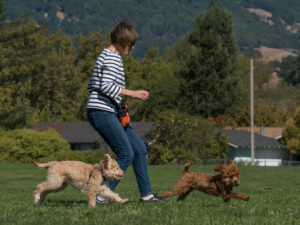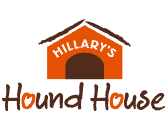
Time to leave the kitchen and venture outside? Relax those expectations.
Like everything puppies learn, they do best in a quiet place where they can focus. You do not want any distractions in the beginning, so it is important to control the environment. Once your puppy gets good at a new skill however, you will be tempted to try it outside and this is where things tend to fall apart. Why?
Distractions.
Take Recall, the most important skill you will ever teach a puppy. This is when you call from a distance and your puppy races back to you. He may have nailed it in the quiet of your backyard, yet now he seems to have no attention span, freezes up, or heads off in the wrong direction. Like all puppy parents, your first thought will be:
He never does this at home!
Famous last words, because you will soon discover all bets are off when you bring a young puppy outdoors.
 Imagine this. You are walking down a lane in a small Italian town. It’s 8am, ocean breezes mingle with the scent of riotously colored flowers bursting from window pots. As you approach a tiny cafe, the smell of cloud eggs, sausage, and espresso fills your senses when suddenly, a group of runners approach. They split up, left and right to run past you. Friendly banter fills the air and for a moment you are immersed in a sea of movement, a tide of pumping arms, legs, breath.
Imagine this. You are walking down a lane in a small Italian town. It’s 8am, ocean breezes mingle with the scent of riotously colored flowers bursting from window pots. As you approach a tiny cafe, the smell of cloud eggs, sausage, and espresso fills your senses when suddenly, a group of runners approach. They split up, left and right to run past you. Friendly banter fills the air and for a moment you are immersed in a sea of movement, a tide of pumping arms, legs, breath.
If it had been a cartoon, you’d have spun around several times. As it is, you will need a moment to reorient yourself and set a new course for the cafe
This is what happens for puppies when crowds appear. Loose dogs (loose children for that matter), traffic, sounds, smells from a restaurant door suddenly flung open. All these things compete for a puppy’s attention. It’s like taking your kids to Disneyland and asking them to do their homework. “Why?!” they’d cry, their attention hijacked by color, movement, sounds, and smells. It’s the same with puppies.
A Puppy’s Imperative
Puppies need to explore the world and learn how to use their body to get places. Like small children, 66% of their brain is dedicated to exploration, so you have some serious competition and sooner you teach your puppy to multitask, the better. In fact, the goal of puppy training is to teach puppies to keep listening and functioning – despite distractions. That is a tall order, but you can do this. First, a few thoughts;
What’s Eye Level for the Goose…
As you prepare to train your puppy outdoors, keep a few things in mind; first, eye level for most young puppies is anywhere from 5″ to 16″ off the ground. They are not (yet) masters of a greater horizon. Rather, a puppy’s domain is the ground beneath him (another reason the socialization process is so important, but that’s a conversation for another day). For now, our goal is to widen our puppy’s horizon and teach him/her how to navigate past or through anything that lies between you; new people, dogs, strollers, bits of food, strange smells – and distinguish which set of legs is yours.
The Adrenaline Imperative
Second, as a puppy’s legs begin to pump and adrenaline floods their brain, they do not watch where they are going. The adrenaline imperative has no time for small talk. It’s like putting a 15-year-old behind the wheel of a Ferrari. They must learn quickly or hit a wall (as they frequently do). So, your goal is to teach your puppy how to think and run at the same time. It’s a skill that does not come factory installed.
In the Jumpstart Program we start all our puppies, regardless of size or age to race to us quickly when we call. By the second day they are racing to us outside in a quiet field. Nevertheless, as we move from field to a noisy mall or busy park we plan for distractions. This means noticing who or what is near each puppy when we call. Is there a play buddy nearby? Strangers with dogs or food? From that puppy’s point of view, are we easily discoverable? Not usually.
How to Stand Out in a Crowd
Once you have trained your puppy to race back when you call, here are some tips to help him/her to find you quickly;
1. Do not call till you have your puppy’s attention. To get it, you may have to make an interesting noise (I make a kissing sound), move quickly, or wave your arms. Remember; where a puppy looks, a puppy is.
2. Once you have got your puppy’s attention call loudly, “Joy, COME!”
3. If the distance is long, the going uneven, use your voice or arms as a beacon. Puppies will follow sound, notice changes in the environment (think prey drive).
4. Pay up immediately, reward lavishly New Math = praise + a positive association (training treat) + blowing off energy. So…
What’s in your pocket?
I kid you not, when I train outdoors with distractions I use bits of roast beef or steak. As a puppy grows bigger, stronger, more confident, you must be able to compete with all the things that grab their attention. And consider this;
If you want your puppy to bring his/her A-Game, you need to bring yours. Every time your puppy races past another distraction to get to you, that’s one more victory in what I hope will be a long and cherished partnership.
Want help teaching your puppy to race back when you call? Check out the Jumpstart Puppy Program at Hillary’s Hound House.


